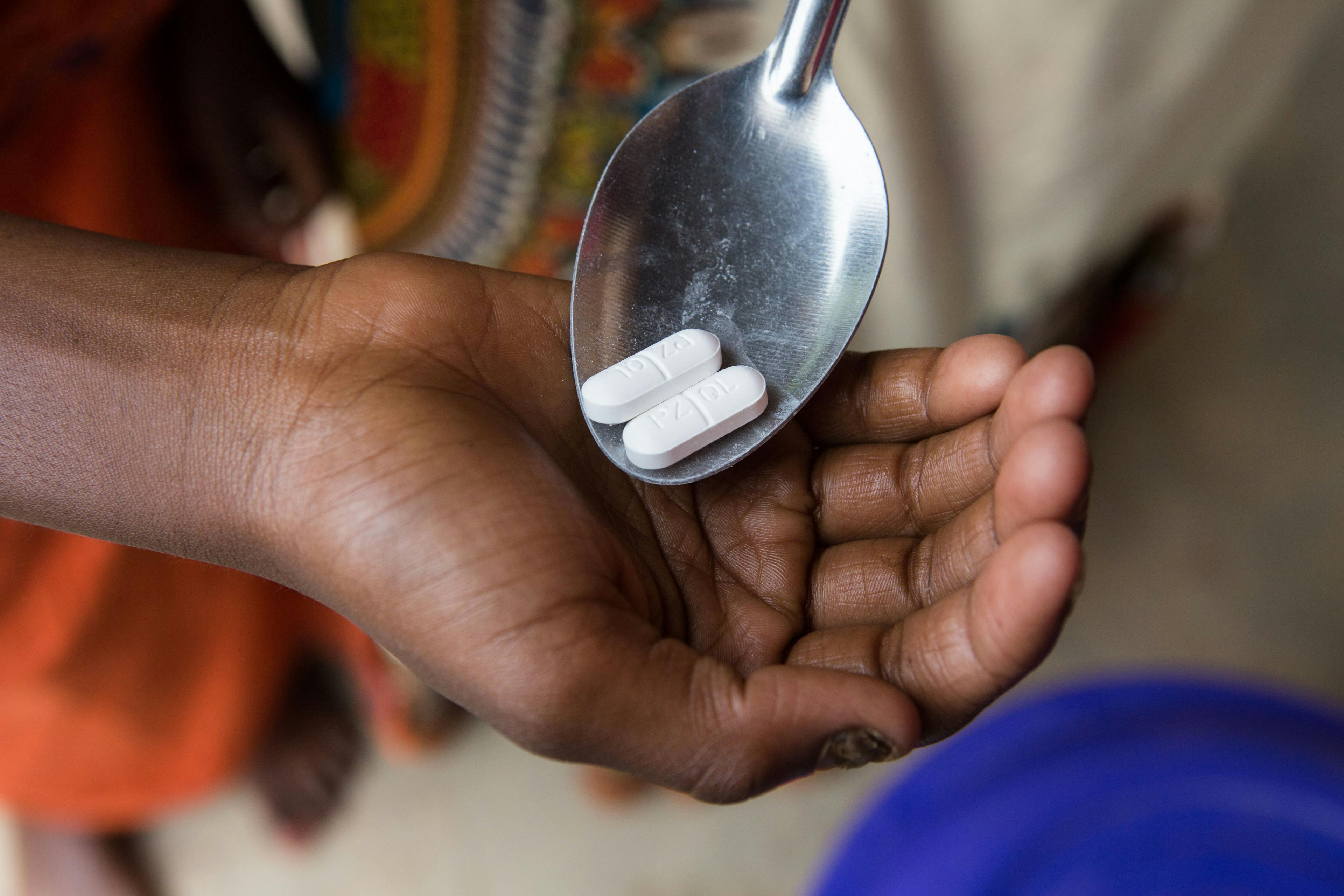Sightsavers' Deworming Program

▲ Photo by Sightsavers in Guinea-Bissau
Related research
We recommend Sightsavers’ deworming program, through which schoolchildren are treated with inexpensive drugs to reduce the harm caused by parasitic worms.
More than a billion people suffer from parasitic intestinal worm infections. Two particularly common afflictions are schistosomiasis and soil-transmitted helminthiasis. Schistosomiasis is transmitted through water contaminated with the larvae of a parasitic worm, and affects roughly 206 million people.1 Soil-transmitted helminthiasis is transmitted through faeces and soil, and affects 1.5 billion people worldwide.2 Children living in severe poverty and without adequate access to sanitation are especially at risk, and there is evidence that worms negatively impact their development and reduce the income they earn later in life.3
The negative effects of these diseases are almost always avoidable. While effective treatments exist, many people in low- and middle-income countries are unable to access them. Poverty, inequality, and a lack of awareness in low- and middle-income countries hamper the distribution of highly effective drugs.4
Sightsavers is a charity focused on preventing avoidable blindness and promoting equal opportunities for people with disabilities in low- and middle-income countries.5 We specifically recommend their deworming program, which GiveWell has identified as particularly cost-effective. Sightsavers’ deworming work includes advocating for programs to be implemented, developing plans, conducting surveys to understand the prevalence of the diseases, training mass drug administration implementers, informing communities about the benefits of deworming, monitoring, and financial support.6
Sightsavers is primarily focused on adding deworming components to the existing infrastructure of the neglected tropical disease programs that they already support in Africa. These programs often focus on mass drug administration to pre-school and school-aged children, who can be targeted through in-school deworming programs, and whose schooling might otherwise be negatively affected.7 Sightsavers also conducts community-based deworming programs, in which trained volunteer drug distributors travel between households or distribute treatments from a fixed community location.8 Target communities are identified in line with the World Health Organization’s minimum prevalence thresholds for mass drug administration.9
We recommend Sightsavers because:
- GiveWell, our research partner in global health and development, recommends Sightsavers as one of the most cost-effective global development organisations in the world.
- There is strong evidence that administration of deworming drugs reduces worm loads.
- There is some evidence that reductions in worm loads lead to improved life outcomes.
We believe that as of March 2023 Sightsavers has room to spend an additional $9.2 million dollars in their most cost-effective regions for our recommended programs in the next three years (2023-2026). $7 million of this is in Nigeria and $2.2 million is in Cameroon.
More Resources
GiveWell write up on Sightsavers’ Deworming Program GiveWell review of the evidence for Deworming Founder Pledge report on Deworming Sightsavers’ website
Notes
-
World Health Organisation. (2020).Soil-transmitted helminth infections. Who.int. Retrieved 18 February 2021 From https://www.who.int/en/news-room/fact-sheets/detail/soil-transmitted-helminth-infections ↩
-
Ibid. ↩
-
“This systematic review and meta-analysis of the cognitive and educational impact of Schistosoma infection in school-aged children supports the hypothesis that infection is associated with reduced school-attendance, with deficits in scholastic achievement and deficits in memory and learning domains of psychometrically evaluated cognitive function.” Ezeamama, A., Bustinduy, A., Nkwata, A., Martinez, L., Pabalan, N., Boivin, M., and King, C. (2018). Cognitive deficits and educational loss in children with schistosome infection—A systematic review and meta-analysis. https://journals.plos.org/plosntds/article?id=10.1371/journal.pntd.0005524 ↩
-
“It was observed that 32.0%, 19.2% and 4.1% of the respondents had correct knowledge about the causes of schistosomiasis, malaria and STHs, respectively, whilst 22.1%, 19.2% and 5.8% knew correct measures to control schistosomiasis, malaria and STHs.” Midzi, N., Mtapuri-Zinyowera, S., Mapingure, N., Paul, N., Sangweme, D., Hlerma, G., Mutsaka, M., Tongogara, F., Makware, G., Chadukur, V., Brouwer, K., Mutapi, F., Kumar, N., and Mduluza, T. Knowledge attitudes and practices of Grade three primary schoolchildren in relation to schistosomiasis, soil transmitted helminthiasis and malaria. BMC Infectious Diseases, 11, 169. (2011). https://bmcinfectdis.biomedcentral.com/articles/10.1186/1471-2334-11-169 ↩
-
Sightsavers. (2015). Descriptions of Current Work. Givewell.org. Retrieved 23 February 2021. From https://files.givewell.org/files/DWDA%202009/Sightsavers/Sightsavers_Descriptions_of_current_work_2015.pdf ↩
-
GiveWell. (2020).Sightsavers’ Deworming Program: What do they do? Givewell.org. Retrieved 23 February 2021. From https://www.givewell.org/charities/sightsavers#Whatdotheydo ↩
-
Ibid. ↩
-
GiveWell. (2020). Sightsavers’ Deworming Program: What types of deworming programs does Sightsavers support? Givewell.org. Retrieved 23 February 2021. From https://www.givewell.org/charities/sightsavers#footnote9_hlebc7j ↩
-
World Health Organization. (2019). Deworming in Children. Who.int. Retrieved 23 February 2021. From https://www.who.int/elena/titles/deworming/en/ ↩